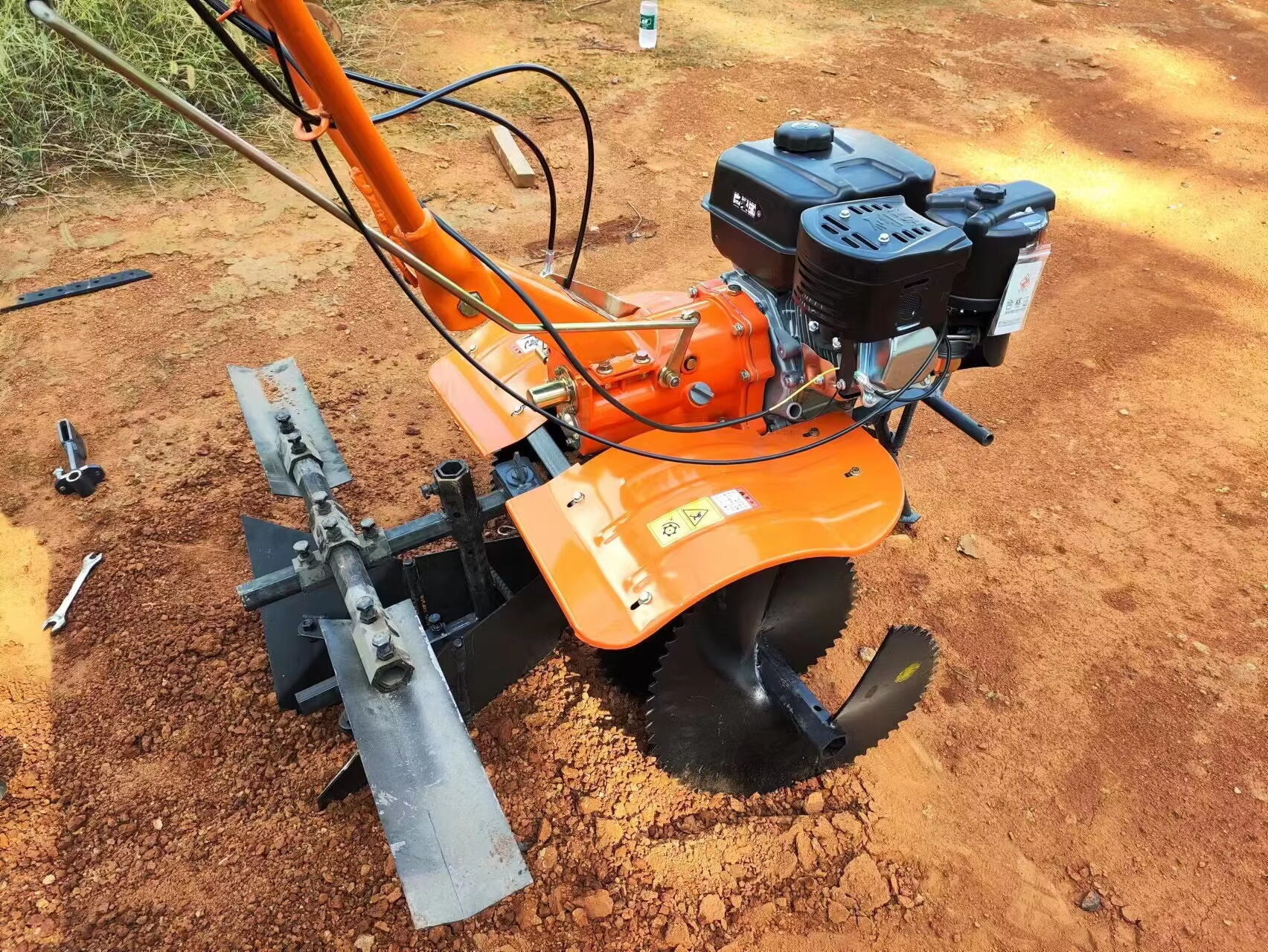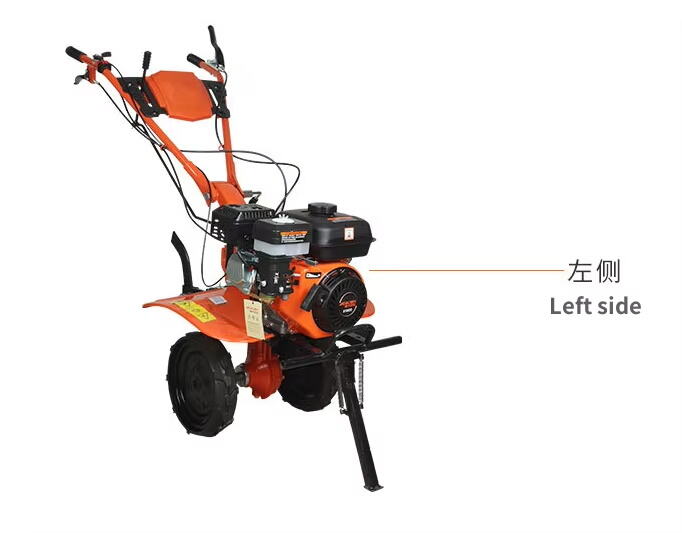အသိပညာပေးသော ကိရိယာများဖြင့် စိုက်ပျိုးရေးစတင်ပါ
ဇီဝအော်ဂဲနစ်စိုက်ပျိုးရေးသည် မြေဆွဲစီမံခန့်ခွဲမှုနှင့် မြေကို ပျက်စီးစေခြင်းမဟုတ်ဘဲ တိုးတက်စေသော စွမ်းဆောင်ရည်များပေါ်တွင် အချိန်မှန်စွာ မှီခိုနေပါသည်။ ဇီဝအော်ဂဲနစ်စိုက်ပျိုးသူတစ်ဦး၏ လက်နက်ကျောက်ဖြစ်သော လှိုင်းလှုပ်စက် ကို စိတ်ကြိုက်စွာ ပေါင်းစပ်ထည့်သွင်းပါက ရောတာရီကွဲလ်တီဗေတာသည် မြေဆွဲဖွဲ့စည်းပုံကို တိုးတက်စေပြီး အာဟာရစုပ်ယူမှုကို ကောင်းမွန်စေကာ မြက်ပေါက်များကို သဘာဝအားဖြင့် လျော့နည်းစေပါသည်။ ဧရိယာကျယ်ကျယ်ကို စီမံခန့်ခွဲခြင်းဖြစ်စေ သေးငယ်သော ဟင်းသီးဟင်းရွက်ဥယျာဉ်များဖြစ်စေ စိုက်ပျိုးသူများသည် ပိုမိုကောင်းမွန်သော အသီးအနှံများကို နည်းပါးသော အသုံးအနှုန်းဖြင့် ထုတ်လုပ်ရရှိနိုင်ရန် ရောတာရီကွဲလ်တီဗေတာများကို ပိုမိုအသုံးပြုလာကြပါသည်။
ဇီဝစနစ်များတွင် ရောတာရီကွဲလ်တီဗေတာအလုပ်လုပ်ပုံ
စက်မှု တူးဖော်ရေးလုပ်ငန်းများအားဖြင့် မြေဆွဲပြုလုပ်ခြင်း
ရောတာယာယီ တူးဖော်ရေးစက်များ မြေပြင်ပေါ်ယံကို တူးဖော်ရာတွင် လှည့်ပတ်နေသော ဓားများ သို့မဟုတ် ကျွဲများကို အသုံးပြုသည်။ ဤလုပ်ငန်းစဉ်သည် မြေကျိုးကပ်နေသော မြေကိုဖြိုဖျက်ပေးပြီး မြေထဲသို့ လေဝင်လေထွက်ကို ကောင်းမွန်စေသည်။ ဓာတုမြေပြုပြင်ဆေးများကို မသုံးသော ဇီဝစနစ်များတွင် အထူးအရေးကြီးသည်။ ရောတာယာယီ တူးဖော်ရေးစက်သည် တူးဖော်ရာတွင် တစ်ညီတစ်ညာ နှင့် အနက်နိမ့်တွင် အလုပ်လုပ်နိုင်သော စွမ်းရည်ကြောင့် ဇီဝစနစ်များတွင် စိုက်ပျိုးရေးမြေကို ပြင်ဆင်ရာတွင် အသင့်တော်
မြေပေါ်ပျော်ပျောက်စေခြင်း နှင့် အမှိုက်စွန့်ပစ်မှုကို စီမံခန့်ခွဲခြင်း
မြေပေါ်ပျော်များသည် ဇီဝစနစ်များတွင် အကြီးမားဆုံးစိန်ခေါ်မှုများထဲမှ တစ်ခုဖြစ်သည်။ ရောတာယာယီ တူးဖော်ရေးစက်သည် မြေပေါ်ပျော်ပျောက်များကို မြေမှ ဖြုတ်ချခြင်း သို့မဟုတ် မြေအောက်သို့ ဖုံးအုပ်ခြင်းဖြင့် မြေပေါ်ပျော်များကို ထိန်းချုပ်ပေးသည်။ ဟားဘစိုင်ဒ်များကို မသုံးဘဲ ထိန်းချုပ်နိုင်သည်။ ထပ်တိုးအားဖြင့် မြေထဲသို့ အပင်အကြွင်းအကျန်များ နှင့် စိမ်းလန်းသော မြေဩဇာများကို ပေါင်းစပ်ကူညီပေးသည်။
ဇီဝမြေဩဇာကို သဘာဝအားဖြင့် တိုးတက်ကောင်းမွန်စေခြင်း
မြေထဲတွင် လေဝင်လေထွက်ကို ပိုကောင်းမွန်စေခြင်း နှင့် ဘက်တီးရီယာလှုပ်ရှားမှုကို တိုးတက်စေခြင်း
မိုးလေဝသအရ မြေဆွေးသည် မိုက်ခရိုဘီယာလုပ်ဆောင်မှုကို တိုးမြှင့်ပေးသည်။ မိုက်ခရိုဘီယာသည် သဘာဝစိုက်ပျိုးရေးတွင် အာဟာရစကြိုးများကို ထိန်းသိမ်းပေးသည်။ လှည့်ပတ်သော မြေထုတ်စက်များသည် မိုက်ခရိုဘီယာကောလိုနီများကို မဖျက်စီးဘဲ မြေကိုချောမွေ့စွာပြောင်းလဲပေးသည်။ အမြစ်စနစ်ကို ကျန်းမာစေပြီး အပင်များကို ခိုင်မာစေသည်။
အာဟာရမျှတစွာဖြစ်စေရန် အော်ဂဲနစ်ပစ္စည်းများကိုရောစပ်ခြင်း
မြေဆွေး၊ ကျွေးမြေ၊ ဖုံးထားသော မြေသီးနှံများသည် သဘာဝအာဟာရဖြည့်တင်းမှု၏ အခြေခံဖြစ်သည်။ လှည့်ပတ်သော မြေထုတ်စက်များသည် စိုက်ပျိုးရာတွင် ထည့်သွင်းထားသော အော်ဂဲနစ်ပစ္စည်းများကို တစ်ခုတည်းဖြစ်စေရန် ထိရောက်စွာရောစပ်ပေးသည်။ အာဟာရပိုမိုတန်းတူဖြစ်စေပြီး အပင်များအသုံးပြုနိုင်သည့်ပုံစံသို့ ပစ္စည်းများကို ပိုမိုမြန်ဆန်စွာပြောင်းလဲပေးသည်။

လုပ်သားနှင့် အချိန်ကိုထိရောက်ထိန်းသိမ်းခြင်း
စိုက်ခင်းပြင်ဆင်မှုတွင် အမြန်နှုန်းနှင့် တစ်ပုံတည်းဖြစ်မှု
လက်နှုတ်ဖြင့်မြေတူးခြင်း သို့မဟုတ် အထူးမဟုတ်သော စက်များနှင့် နှိုင်းယှဉ်ပါက လှည့်ပတ်သော မြေထုတ်စက်များသည် စိုက်ခင်းပြင်ဆင်ရေးတွင် လိုအပ်သော အချိန်နှင့် လုပ်သားကို သက်သာစေသည်။ ကျယ်ပြန့်သောဧရိယာများကို အမြန်ဖုံးလွှမ်းနိုင်ပြီး မြေတူးရာတွင် နက်နှုန်းတစ်ပုံတည်းဖြစ်မှုကို ထိန်းသိမ်းထားနိုင်သောကြောင့် ထိရောက်မှုများပြားသည်။ အထူးသဖြင့် စိုက်ပျိုးရက်ထူသောကာလများတွင် ပိုမိုအသုံးဝင်သည်။
မြေဆိုးမှုကိုလျော့နည်းစေရန်အတွက် ကုန်ဆုံးမှုအနည်းငယ်ဖြင့် ပြုလုပ်ခြင်း
ဓားပြွန်တပ်တဲ့ မြေလှန်စက်တွေက အများအားဖြင့် တစ်ခါ သို့မဟုတ် နှစ်ခါ ပြုလုပ်ခြင်းဖြင့် အလုပ်ကိုပြီးစီးစေတတ်ပါတယ်။ ဒါက မြေဆုပ်ကိုလျော့နည်းစေပြီး မြေဆိုးမှုကို ကန့်သတ်ထားပါတယ်။ အများကြီး မြေလှန်တာကို မလိုလားတဲ့ ဇီဝကစားမြေစိုက်ပျိုးရေးမှာ ဒီတစ်ခါတည်းပြုလုပ်နိုင်မှုက မြေယာစီမံခန့်ခွဲမှုကို တိုက်ရိုက်ကိုက်ညီပါတယ်။
ပိုးမွှားနှင့် ရောဂါများကို ထိန်းချုပ်ရာတွင် ကူညီပေးခြင်း
ဓာတုပစ္စည်းများမသုံးဘဲ ပိုးမွှားများ၏ နေရာများကို ဖျက်စီးပေးခြင်း
မြေဆီလွှာတွင်ရှိသော ပိုးမွှားများနှင့် ရောဂါဘယများစွာတို့သည် အနှောက်အယှက်ကင်းသော ပတ်ဝန်းကျင်တွင် ရှင်သန်ကြသည်။ Rotary စိုက်ပျိုးသူများသည် မြေမျက်နှာပြင်ကို မွှေနှောက်ပြီး အန္တရာယ်ရှိသော သက်ရှိများ ပွားများနိုင်သည့် အခြေအနေများကို လျှော့ချခြင်းဖြင့် အဆိုပါ နေထိုင်ရာနေရာများကို အနှောင့်အယှက်ပေးသည်။ ဤရုပ်ပိုင်းဆိုင်ရာထိန်းချုပ်မှုနည်းလမ်းသည် အော်ဂဲနစ်စိုက်ပျိုးရေးတွင်အသုံးပြုသော ပေါင်းစည်းပိုးမွှားစီမံခန့်ခွဲမှုစနစ်များ၏ အဖိုးတန်အစိတ်အပိုင်းတစ်ခုဖြစ်သည်။
စိုက်ပျိုးထားသော အပင်ကြွင်းများကို မြန်မြန်ဆန်ဆန် ပျက်စီးသွားစေရန် အားပေးခြင်း
ကြွင်းကျန်သော အပင်စွန့်ပစ်ပစ္စည်းများသည် မျောက်ဘေးပိုးမွှားများကို သယ်ဆောင်ထားနိုင်သည်။ လက်ပတ်တူးဖော်သည့် စက်များသည် ထိုကျန်ရှိနေသော အပင်စွန့်ပစ္စည်းများကို မြေဆွေးအဖြစ် အမြန်ပြုပြင်ပေးကာ နှစ်များအတွင်း ရောဂါများ ကူးစက်မှုကိုလည်း လျော့နည်းစေသည်။ ဤလုပ်ငန်းစဉ်သည် မြေဆွေးကို မြေထဲသို့ ပြန်လည်ထည့်သွင်းပေးခြင်းဖြင့် မြေဆိုင်ရာ ကောင်းမွန်မှုကို ရရှိစေသည်။
ဇီဝစိုက်ပျိုးမှုနှင့် ကိုက်ညီမှုရှိသော စိတ်ကြိုက်ပြင်ဆင်နိုင်မှု
စိုက်ပျိုးမွေးမြူရေး စက်များနှင့် အကျိုးအမြတ်အတွက် ကိုက်ညီမှုရှိသော စိတ်ကြိုက်ပြင်ဆင်နိုင်မှု
လက်ပတ်တူးဖော်သည့် စက်များသည် အရွယ်အစားနှင့် ပုံစံများစွာဖြင့် ထုတ်လုပ်ထားသည်။ လက်နှင့်တွန်းလှည့်သော စက်များမှသည် ကျယ်ပြန့်သော စိုက်ခင်းများအတွက် စက်ကြီးများအထိ အမျိုးမျိုးသော စိုက်ပျိုးမှုစနစ်များနှင့် ကိုက်ညီအောင် စိတ်ကြိုက်ပြင်ဆင်နိုင်သည်။ ဤစိတ်ကြိုက်ပြင်ဆင်နိုင်မှုသည် ဇီဝစိုက်ပျိုးမှုအတွက် အကျိုးရှိသော ရင်းနှီးမြှုပ်နှံမှုတစ်ခုဖြစ်သည်။
ဇီဝစိုက်ပျိုးမှုနှင့် ကိုက်ညီသော စက်ပစ္စည်းများ
ပုံမှန်တြပ်တာများ သို့မဟုတ် ဇီဝဗေဒ စိုက်ပျိုးရေးတွင် အသုံးများသော လမ်းလျှောက်နောက်ကျောခံယူနစ်များနှင့် အလုပ်လုပ်ရန် ဒီဇိုင်းထုတ်ထားသော ရောတာရီ ကူးလီဗေတာများစွာရှိပါသည်။ ၎င်းတို့၏ ရိုးရှင်းသော စက်မှု ဖွဲ့စည်းပုံမှုကြောင့် အနည်းငယ်သာ ထိန်းသိမ်းရန်လိုအပ်ပြီး ကိုယ်ပိုင်ပစ္စည်းများ သို့မဟုတ် ဝန်ဆောင်မှု ကွန်ရက်များအပေါ် မှီခိုမှုကို လျော့နည်းစေရန် အများအားဖြင့် နေရာတွင်ပင် ပြုပြင်နိုင်ပါသည်။
ဇီဝဗေဒ မြေဩဇာစီမံခန့်ခွဲမှုမှတဆင့် စိုက်ပျိုးထုတ်လုပ်မှုများကို မြှင့်တင်ခြင်း
မြေဆုကျောင်းမှုကို တိုးတက်စေခြင်း
မြေကို သင့်တော်စွာတူးဖော်ပေးပါက စိုက်ပျိုးသည့်အခါ စိုက်ပျိုးသော စိုက်ပျိုးမှုများသည် စိုစွတ်သောမြေနှင့် တစ်ညီတစ်ညာ ထိတွေ့နိုင်ပြီး ပိုကောင်းသော ပေါက်ရောက်နှုန်းကို တွန်းအားပေးပါသည်။ ရောတာရီကူးလီဗေတာများသည် စိုက်ပျိုးရေးကို တစ်ညီတည်းဖြစ်စေရန် ကူညီပေးပြီး ဇီဝဗေဒစနစ်များတွင် တစ်ပင်ချင်းစီကို တိကျစွာ သိရှိနိုင်ပြီး ထုတ်လုပ်မှုပိုမိုများပြားစေရန် ကူညီပေးပါသည်။
မြေထဲတွင် စိုစွတ်မှုကို ထိန်းသိမ်းခြင်း
ရောတာရီကူးလီဗေတာများသည် ရေငွေ့ပျံ့မှုကို ကာကွယ်ရန် အလွှာလေးကို ဖန်တီးရာတွင် ကူညီပေးပါသည်။ ဤအလွှာလေးသည် ဇီဝဗေဒ စိုက်ပျိုးသူများအား ရေကို သိမ်းဆည်းထားရှိရန် ကူညီပေးပြီး အထူးသဖြင့် ရေအားနည်းသော အပူပိုင်းဒေသများတွင် စိုက်ပျိုးရေးကို လျော့နည်းစေပြီး ရေအသုံးပြုမှု ထိရောက်မှုရည်မှန်းချက်များကို ထောက်ပံ့ပေးပါသည်။
ပြန်လည်ထူထောင်ရေး စိုက်ပျိုးရေးနည်းပညာများကို တွန်းအားပေးခြင်း
အုပ်စုပ်စားသော မျိုးစိတ်များကို စိုက်ပျိုးရေးသို့ ပေါင်းစည်းပေးခြင်း
ပြန်လည်ထုတ်လုပ်သော စိုက်ပျိုးရေးနှင့် ဇီဝစိုက်ပျိုးရေးတို့တွင် အုပ်စုပ်စားသော မျိုးစိတ်များမှာ အဓိကအချက်ဖြစ်ပါသည်။ မြေဆွဖျော့စက်များသည် မြေဆွလုပ်ရာတွင် အချိန်မှန်မှန် အသုံးပြုခြင်းဖြင့် မြေဩဇာကောင်းမွန်လာစေကာ မြေပေါ်ရှိ အပင်များကို သဘာဝအားဖြင့် တားဆီးနိုင်ပါသည်။ မြေဆွလုပ်ရာတွင် မြေကိုနည်းနည်းသာ ထိခိုက်စေပြီး အာဟာရပြန်လည် အသုံးချမှုကို အများဆုံးဖြစ်စေရန် တိကျသော စက်များက သေချာစေပါသည်။
စိုက်ပျိုးရေးမှ ဓာတုပစ္စည်းများအသုံးပြုမှုကို လျော့နည်းစေရန် ကူညီပေးခြင်း
တရားဝင် ဇီဝစိုက်ပျိုးရေးသို့ ပြောင်းလဲနေသော စိုက်ပျိုးရေးများအတွက် မြေဆွဖျော့စက်များသည် မြေပေါ်ရှိ အပင်များနှင့် မြေကို စီမံခန့်ခွဲရာတွင် စက်များအားဖြင့် ဖြေရှင်းပေးနိုင်ပါသည်။ ဤစက်များသည် ပြောင်းလဲမှုလုပ်ငန်းစဉ်အစတွင် ဓာတုပစ္စည်းများအသုံးပြုမှုကို လျော့နည်းစေပြီး ဓာတုပစ္စည်းများမပါသော ကျန်းမာသော မျိုးစိတ်များကို ထုတ်လုပ်ရာတွင် ကူညီပေးပါသည်။
ဇီဝစိုက်ပျိုးရေးတွင် မြေဆွဖျော့စက်များ၏ အသုံးဝင်မှုနှင့် တန်ဖိုး
ခံနိုင်ရည်ရှိပြီး ပြုပြင်ထိန်းသိမ်းမှုလိုအပ်ချက်များနည်းပါးခြင်း
ရောတာရီ ကူလီဗေတာများသည် တည်ဆောက်မှု ခိုင်မာပြီး အသုံးပြုနိုင်သည့် သက်တမ်းရှည်ကြာမှုတို့ဖြင့် ထင်ရှားပါသည်။ ရှုပ်ထွေးသော စိုက်ပျိုးရေးစက်မှုလက်နက်များကဲ့သို့ ရွေ့လျားနေသော အစိတ်အပိုင်းနည်းပါးမှုကြောင့် ထိန်းသိမ်းရန် လွယ်ကူပြီး အချိန်ကြာလာသည်နှင့်အမျှ စျေးနှုန်းထိန်းသိမ်းရေးအရ အကျိုးဖြစ်ထွန်းစေပါသည်။ အထူးသဖြင့် တာဝန်ခံစွာထုတ်လုပ်မှုနှင့် သက်တမ်းရှည်ကြာမှုတို့သည် အင်းဆက်များနှင့် တစ်သေတည်းဖြစ်နေသော စနစ်များတွင် အလွန်တန်ဖိုးရှိပါသည်။
ဇီဝစိုက်ပျိုးသူများအတွက် ရင်းနှီးမြှုပ်နှံမှုပြန်လည်ရရှိမှု
စက်ပစ္စည်းများဝယ်ယူရာတွင် ဇီဝစိုက်ပျိုးသူများသည် စျေးနှုန်းနှင့် တန်ဖိုးကို စိတ်ကြိုက်စွာ ဆန်းစစ်ရပါမည်။ ရောတာရီကူလီဗေတာများသည် ပိုမိုကောင်းမွန်သော ထုတ်လုပ်မှုကို ဖြစ်စေခြင်း၊ လုပ်သားစရိတ်ကို လျော့နည်းစေခြင်းနှင့် မြေဆိုင်ရာကျန်းမာရေးကို တိုးတက်စေခြင်းတို့ဖြင့် ပြန်လည်ရရှိမှုကို အားကောင်းစေပါသည်။ ဓာတုပစ္စည်းများကို အသုံးမပြုဘဲ ရှည်ကြာသော မြေဆိုင်ရာ ထုတ်လုပ်မှုစွမ်းရည်ကို ရရှိရန်တွင် အဓိက ရင်းနှီးမြှုပ်နှံမှုအဖြစ် သတ်မှတ်ထားပါသည်။
မေးလေ့ရှိသောမေးခွန်းများ
ဇီဝစိုက်ပျိုးရေးတွင် ရောတာရီကူလီဗေတာကို မည်မျှကြိမ်အသုံးပြုသင့်ပါသနည်း။
အသုံးပြုမှုကြိမ်နှုန်းသည် မြေဆိုင်ရာအမျိုးအစား၊ မျိုးစုံလှည့်ပတ်မှုနှင့် ပင်လယ်များ၏ ဖိအားတို့ပေါ်တွင် မူတည်ပါသည်။ ဇီဝစနစ်များတွင် ရောတာရီကူလီဗေတာများကို အများအားဖြင့် စိုက်ပျိုးမှီ မြေဆွေးပြင်ဆင်ရန်နှင့် တစ်ခါတစ်ရံတွင် ပင်လယ်များကို ထိန်းချုပ်ရန် အသုံးပြုပါသည်။
လှည့်စီးပြုပြင်သည့် စက်များကို မြေမျိုးစုံတွင် အသုံးပြုနိုင်ပါသလား။
လှည့်စီးပြုပြင်သည့် စက်များကို အလေးချိန်ပေါ့ပါးသော မြေမှ အလယ်အလတ်မြေအထိ အကောင်းဆုံးအသုံးပြုနိုင်ပါသည်။ မြေခဲ သို့မဟုတ် ကျောက်များပါသော မြေများအတွက် အထူးသီးနှံများ သို့မဟုတ် ်လေ့ဒ်အညွှန်းတွင် အပ်ဒိတ်များ လိုအပ်ပါလိမ့်မည်။ သင့်တော်သော မော်ဒယ်ကို သင့်၏ မြေပုံစံအတွက် ရွေးချယ်ရန် အရေးကြီးပါသည်။
ဇီဝဗေဒ စိုက်ပျိုးရေးတွင် မြေဘက်တီးရီးယားများအတွက် လှည့်စီးပြုပြင်သည့် စက်များသည် ဘေးကင်းပါသလား။
ဟုတ်ပါသည်။ လှည့်စီးပြုပြင်သည့် စက်များကို မှန်ကန်စွာအသုံးပြုပါက ဘက်တီးရီးယားများကို ထိန်းသိမ်းထားနိုင်ပါသည်။ နက်နဲသော မြေတူးခြင်းကဲ့သို့မဟုတ် မြေပြင်ပိုင်းကို အနည်းငယ်သာ တူးဖော်ပေးသောကြောင့် ဇီဝဗေဒစနစ်တွင် အာဟာရဖြန့်ဝေရာတွင် အထောက်အကူဖြစ်သော မြေထဲတွင်ရှိသော သက်ရှိအရာများကို ထိန်းသိမ်းထားပေးပါသည်။
သေးငယ်သော ဇီဝဗေဒစိုက်ပျိုးရေးအတွက် လှည့်စီးပြုပြင်သည့် စက်၏ အရွယ်အစားသည် မည်မျှအထိ အကောင်းဆုံးလဲ။
သေးငယ်သော စိုက်ခင်းများ သို့မဟုတ် စျေးကွက်စိုက်ခင်းများအတွက် လမ်းလျှောက်နေစဉ် အသုံးပြုနိုင်သော သေးငယ်သော လှည့်စီးပြုပြင်သည့် စက်များသည် အများအားဖြင့် လုံလောက်ပါသည်။ ဤမော်ဒယ်များသည် တစ်ဧကအောက်ရှိ စိုက်ခင်းများအတွက် လှုပ်ရှားရန် လွယ်ကူပြီး ထိရောက်မှုရှိပါသည်။ ကြီးမားသော စိုက်ခင်းများအတွက် ကျယ်ပြန့်သော ဧရိယာများအတွက် တဲ့ရုတ်စက်များကို တပ်ဆင်ထားသော မော်ဒယ်များကို အကျိုးရှိစွာ အသုံးပြုနိုင်ပါသည်။
အကြောင်းအရာများ
- အသိပညာပေးသော ကိရိယာများဖြင့် စိုက်ပျိုးရေးစတင်ပါ
- ဇီဝစနစ်များတွင် ရောတာရီကွဲလ်တီဗေတာအလုပ်လုပ်ပုံ
- ဇီဝမြေဩဇာကို သဘာဝအားဖြင့် တိုးတက်ကောင်းမွန်စေခြင်း
- လုပ်သားနှင့် အချိန်ကိုထိရောက်ထိန်းသိမ်းခြင်း
- ပိုးမွှားနှင့် ရောဂါများကို ထိန်းချုပ်ရာတွင် ကူညီပေးခြင်း
- ဇီဝစိုက်ပျိုးမှုနှင့် ကိုက်ညီမှုရှိသော စိတ်ကြိုက်ပြင်ဆင်နိုင်မှု
- ဇီဝဗေဒ မြေဩဇာစီမံခန့်ခွဲမှုမှတဆင့် စိုက်ပျိုးထုတ်လုပ်မှုများကို မြှင့်တင်ခြင်း
- ပြန်လည်ထူထောင်ရေး စိုက်ပျိုးရေးနည်းပညာများကို တွန်းအားပေးခြင်း
- ဇီဝစိုက်ပျိုးရေးတွင် မြေဆွဖျော့စက်များ၏ အသုံးဝင်မှုနှင့် တန်ဖိုး
-
မေးလေ့ရှိသောမေးခွန်းများ
- ဇီဝစိုက်ပျိုးရေးတွင် ရောတာရီကူလီဗေတာကို မည်မျှကြိမ်အသုံးပြုသင့်ပါသနည်း။
- လှည့်စီးပြုပြင်သည့် စက်များကို မြေမျိုးစုံတွင် အသုံးပြုနိုင်ပါသလား။
- ဇီဝဗေဒ စိုက်ပျိုးရေးတွင် မြေဘက်တီးရီးယားများအတွက် လှည့်စီးပြုပြင်သည့် စက်များသည် ဘေးကင်းပါသလား။
- သေးငယ်သော ဇီဝဗေဒစိုက်ပျိုးရေးအတွက် လှည့်စီးပြုပြင်သည့် စက်၏ အရွယ်အစားသည် မည်မျှအထိ အကောင်းဆုံးလဲ။

